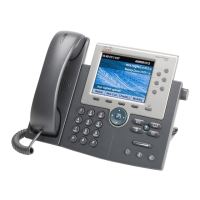1-5
Cisco Unified IP Phone 7965G and 7945G Administration Guide for Cisco Unified Communications Manager 6.0
OL-12650-01
Chapter 1 An Overview of the Cisco Unified IP Phone
What Networking Protocols Are Used?
Dynamic Host
Configuration Protocol
(DHCP)
DHCP dynamically allocates and
assigns an IP address to network
devices.
DHCP enables you to connect an IP
phone into the network and have the
phone become operational without
you needing to manually assign an IP
address or to configure additional
network parameters.
DHCP is enabled by default. If
disabled, you must manually
configure the IP address, subnet
mask, gateway, and a TFTP server on
each phone locally.
Cisco recommends that you use
DHCP custom option 150. With this
method, you configure the TFTP
server IP address as the option value.
For additional information about
DCHP configurations, refer to the
“Cisco TFTP” chapter in Cisco
Unified
Communications Manager
System Guide.
Hypertext Transfer
Protocol (HTTP)
HTTP is the standard way of
transferring information and moving
documents across the Internet and the
web.
Cisco Unified IP Phones use HTTP
for the XML services and for
troubleshooting purposes.
IEEE 802.1X The IEEE 802.1X standard defines a
client-server-based access control
and authentication protocol that
restricts unauthorized clients from
connecting to a LAN through
publicly accessible ports.
Until the client is authenticated,
802.1X access control allows only
Extensible Authentication Protocol
over LAN (EAPOL) traffic through
the port to which the client is
connected. After authentication is
successful, normal traffic can pass
through the port.
The Cisco Unified IP Phone
implements the IEEE 802.1X
standard by providing support for the
EAP-MD5 option for 802.1X
authentication.
When 802.1X authentication is
enabled on the phone, you should
disable the PC port and voice VLAN.
Refer to the
“Supporting 802.1X
Authentication on Cisco Unified IP
Phones” section on page 1-16 for
additional information.
Internet Protocol (IP) IP is a messaging protocol that
addresses and sends packets across
the network.
To communicate using IP, network
devices must have an assigned IP
address, subnet, and gateway.
IP addresses, subnets, and gateways
identifications are automatically
assigned if you are using the Cisco
Unified
IP Phone with Dynamic Host
Configuration Protocol (DHCP). If
you are not using DHCP, you must
manually assign these properties to
each phone locally.
Table 1-1 Supported Networking Protocols on the Cisco Unified IP Phone (continued)
Networking Protocol Purpose Usage Notes

